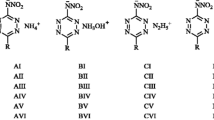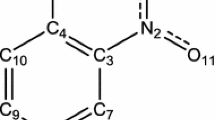Abstract
In the present study, proton transfer from nitric and maleic acids to amine group (4-chloroaniline) led to hydrogen bonded crystals of 4-chloroanilinium maleate (4CAM) and 4-chloroanilinium nitrate (4CAN) which are investigated by the experimental and theoretical approaches. The molecular structures of these two compounds were optimized with the Density Functional Theory (DFT) using B3LYP function and the Hartree-Fock (HF) level with a6-311 ++G(d,p) basis set. Geometrical parameters of the molecules were also analyzed along with their intermolecular hydrogen bond, which tailors the ions. These analyses show that present molecules are stabilized through the N–H ⋯O and O–H ⋯O hydrogen bonds. The vibrational modes were computed by quantum chemical methods. Further, these modes are investigated by FT-IR and FT-Raman spectroscopy in the range of 4000–400 cm−1. The optimized molecular geometry and computed vibrational spectra are compared with experimental results, which show significant agreement. The natural bond orbital (NBO) analysis was carried out to interpret hyperconjucative interaction and intramolecular charge transfer (ICT). This analysis gives the precise insight into the nature of H-bond interactions. The chemical hardness, electronegativity and chemical potential of the molecules were determined by HOMO–LUMO plot. The frontier molecular orbitals have small band gap value, which signify the possible biological/pharmaceutical activity of the compounds.

The proton transfer from the nitric and maleic acids to amine group (of 4-chloroaniline) lead to hydrogen bonded crystals of 4-chloroanilinium maleate (4CAM) and 4-chloroanilinium nitrate (4CAN). The molecular structures of these two compounds were optimized with the Density Functional Theory (DFT) and Hartree-Fock (HF) methods. Geometrical parameters of the molecules were analyzed along with their intermolecular hydrogen bond which tailors the ions. These analyses show that the molecular aggregations are stabilized through the N–H···O and O– H···O hydrogen bonds. The vibrational modes were computed by quantum chemical methods and further investigated by FT-IR and FT- Raman spectroscopy in the range of 4000–400 cm-1.








Similar content being viewed by others
References
Deechongkit S, Nguyen H, Powers E T, Dawson P E, Gruebele M and Kelly J W 2004 Nature 430 101
Lopez N, Vos T E, Arif A M, Shum W W, Noveron J S and Miller J S 2006 Inorg. Chem. 45 4325
Senes A, Ubarretxena-Belandia I and Engelman D M 1998 Proc. Natl. Acad. Sci. USA p. 9056
Parker L L, Houk A R and Jensen J H 2006 J. Am. Chem. Soc. 128 9863
Aakeroy C B and Seddon K R 1993 Chem. Soc. Rev. 22 397
Desiraju G R 1989 In Crystal Engineering: The Design of Organic Solids (Amsterdam: Elsevier)
Harms K and Wocadlo S 1995 In XCAD4 (Germany: University of Marburg)
Sheldrick G M 2008 Acta Cryst. A 64 112
Farrugia L J 1997 J. Appl. Cryst. 30 565
Macrae C F, Edgington P R, McCabe P, Pidcock E, Shields G P, Taylor R, Towler M and Van de Streek J 2006 J. Appl. Cryst. 39 453
Frisch M J, Trucks G W, Schlegel H B, Scuseria G E, Robb M A, Cheeseman J R, Scalmani G, Barone V, Mennucci B, Petersson G A, Nakatsuji H, Caricato M, Li X, Hratchian H P, Izmaylov A F, Bloino J, Zheng G, Sonnenberg J L, Hada M, Ehara M, Toyota K, Fukuda R, Hasegawa J, Ishida M, Nakajima T, Honda Y, Kitao O, Nakai H, Vreven T, Montgomery J A, Peralta J E, Ogliaro F, Bearpark M, Heyd J J, Brothers E, Kudin K N, Staroverov V N, Kobayashi R, Normand J, Raghavachari K, Rendell A, Burant J C, Iyengar S S, Tomasi J, Cossi M, Rega N, Millam J M, Klene M, Knox J E, Cross J B, Bakken V, Adamo C, Jaramillo J, Gomperts R, Stratmann R E, Yazyev O, Austin A J, Cammi R, Pomelli C, Ochterski J W, Martin R L, Morokuma K, Zakrzewski V G, Voth G A, Salvador P, Dannenberg J J, Dapprich S, Daniels A D, Farkas O, Foresman J B, Ortiz J V, Cioslowski J and Fox D J 2013 Gaussian 09, Revision A.1, Gaussian, Inc., Wallingford CT
Schlegel H B 1982 J. Comput. Chem. 3 214
Hohenberg P and Kohn W 1964 Phys. Rev. B 136 864
Becke A D 1993 J. Chem. Phys. 98 5648
Dennington R, Keith T and Millam J 2009 J. Semichem Inc., Shawnee Mission KS
Anitha R, Athimoolam S, Asath Bahadur S and Gunasekaran M 2012 Acta Cryst. E 68 o959
Sidir I, Sidir Y G, Kumalar M and Tasal E 2010 J. Mol. Struct. 964 134
Ploug-Sørensen G and Andersen E K 1983 Acta Cryst. C 39 112
Kurt M, Yurdakul M and Yurdakul S 2004 J. Mol. Struct. (Theochem.) 711 25
Krishnakumar V and John Xavier R 2005 Spectrochim. Acta Part A 61 253
Socrates G 1980 In Infrared Characteristics Group Frequencies (New York: John Wiley)
Lampert H, Mikenda W and Karpten A 1997 J. Phys. Chem. A 101 2254
Banwell C N and Mccash E M 1995 In Fundamentals of Molecular Spectroscopy 4th ed. (New Delhi: Tata McGraw Hill)
Dollish F R, Fateley W G and Bentley F F 1973 In Characteristic Raman Frequencies of Organic-Compounds (New York: Wiley)
Rosenthal M R 1973 J. Chem. Educ. 50 331
Reed A E, Curtis L A and Weinhold F A 1988 Chem. Rev. 88 899
Szafran M, Komasa A and Adamska E B 2007 J. Mol. Struct. (THEOCHEM) 827 101
James C, Amal Raj A, Reghunathan J. I H and Jayakumar V S 2006 J. Raman Spectrosc. 37 1381
Na L J, Rang C Z and Fang Y Z J 2005 Zhejiang Univ. Sci. B 6 584
Fleming I 1976 In Frontier Orbitals and Organic Chemical Reactions (New York: John Wiley)
Acknowledgement
The authors SA and SSK thank the Department of Science and Technology, SERB for the financial support of this work in the form of Fasttrack Research Project scheme.
Author information
Authors and Affiliations
Corresponding author
Additional information
Supplementary Information
X-ray crystallography data of the compound, 4CAM, is available in Cambridge Structural Database (CSD), Ref No: 877151.
Electronic supplementary material
Below is the link to the electronic supplementary material.
Rights and permissions
About this article
Cite this article
ANITHA, R., GUNASEKARAN, M., KUMAR, S.S. et al. Structural and vibrational spectral studies on hydrogen bonded salts: 4-chloroanilinium maleate and nitrate. J Chem Sci 127, 1435–1450 (2015). https://doi.org/10.1007/s12039-015-0914-y
Received:
Revised:
Accepted:
Published:
Issue Date:
DOI: https://doi.org/10.1007/s12039-015-0914-y




